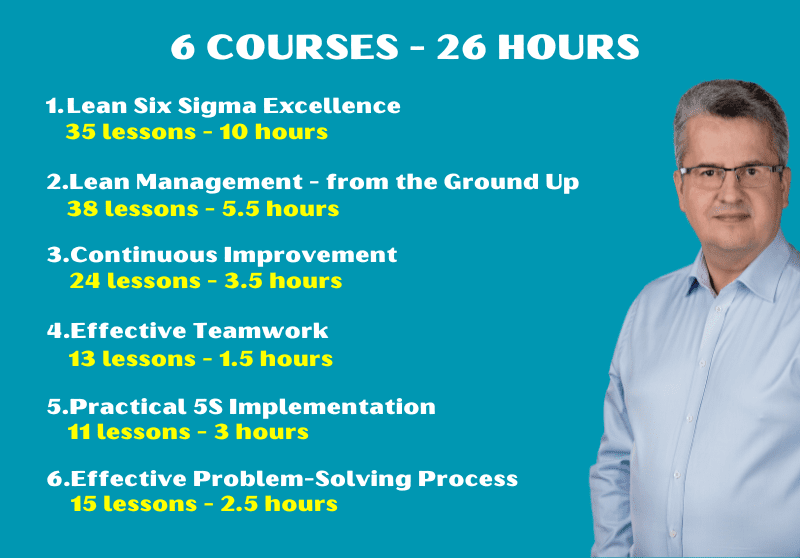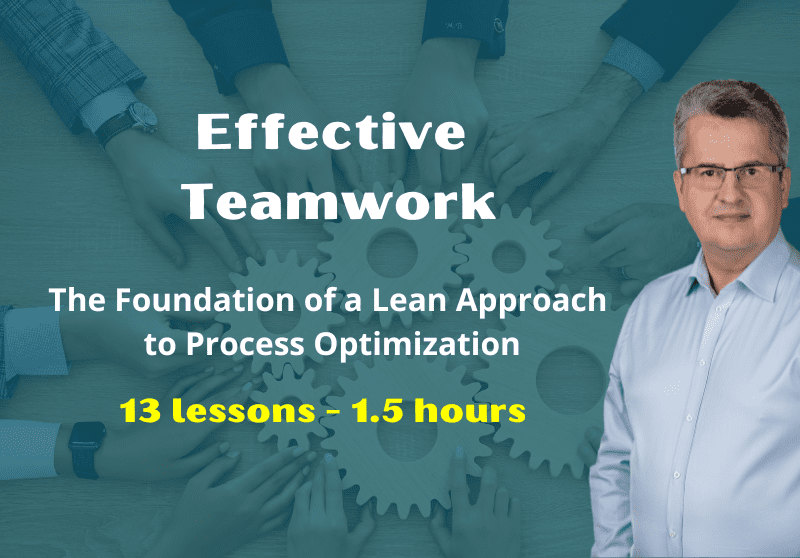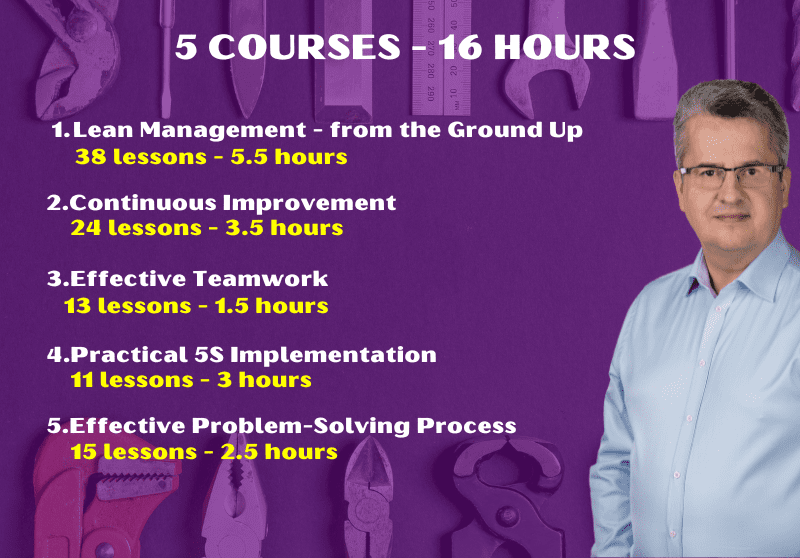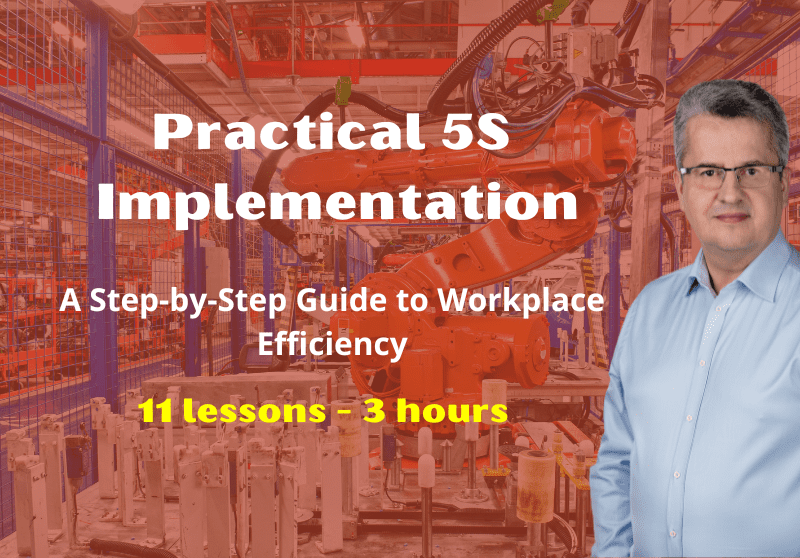Introduction to Lean Six Sigma - 11 min 58 sec
Welcome to our course, which is dedicated to the Six Sigma concept. In this course, we will explore a methodology that leverages statistical tools to eliminate defects and reduce variability in operational processes. We will examine how data-driven decision-making, rather than relying solely on intuition, can lower costs and enhance the quality of products and services. Practical examples across various industries will provide you with the insights necessary to implement practical organizational improvements.
Historical Context and Modern Use of Six Sigma – 17 min 30 sec
This training segment explores the evolution and practical application of Six Sigma, bridging historical insights with modern methodologies. It explores how classical statistical tools and continuous improvement theories have shaped today’s quality management practices. Participants will examine key frameworks, such as PDCA, DMAIC, and DMADV, and explore real-world examples from industry leaders like Toyota, Motorola, and GE. This comprehensive overview equips you with the knowledge to drive operational excellence and sustainable organizational change.
Integration of Six Sigma with other process improvement methods 14 min 17 sec
This lesson explores how Six Sigma can effectively integrate with other quality management methodologies. It examines complementary approaches, including Lean, TQM, BPR, Agile/Scrum, CEM, JumpStart, and the Rummler-Brache model, to create a robust process improvement system. You will learn when to apply each method to eliminate defects, boost operational efficiency, and maximize customer value. Ultimately, this session equips you with the tools to develop a cohesive, high-quality strategy that delivers sustainable financial and operational benefits.
Integration of Six Sigma with Lean Management – 15 min 39 sec
This lesson explores the powerful synergy between Lean Management and Six Sigma. It highlights how Lean eliminates waste while Six Sigma reduces variability, driving cost reductions, higher quality, and improved process efficiency. You'll learn to continuously improve and optimize your organization's operations through practical examples and tools such as 5S, Just-in-Time, Value Stream Mapping, Kaizen, and Poka-Yoke.
Understanding and Applying Standard Deviation in Lean Six Sigma – 16 min 15 sec
This lesson examines the fundamental statistical tools of Lean Six Sigma, concentrating on how standard deviation and variability influence process quality. You will learn to calculate, interpret, and monitor key metrics, understand process shifts and their impact on defect levels, and utilize software tools such as Excel and Minitab for data analysis. This session equips you with the skills to drive continuous improvement and achieve operational excellence.
The Pareto Principle in Lean Six Sigma. The key to prioritizing actions – 4 min 46 sec
This lesson explores harnessing the Pareto Principle (also known as the 80/20 rule) within Lean Six Sigma to identify and focus on the critical causes that drive the majority of defects or losses. By comparing theoretical ratios with real-world data, you will learn to prioritize improvement efforts where they matter most, ultimately enhancing process quality, reducing waste, and boosting efficiency.
Precise Quality Control: Six Sigma Metrics and the Voice of the Customer (VOC) in Process Improvement – 12 min 05 sec
This lesson dives into the precise measurements used in Six Sigma projects—such as DPMO, DPU, FTY, and RTY—to assess process performance and determine how close processes are to achieving ideal sigma levels. Alongside these metrics, we explore the Voice of the Customer (VOC) to understand how customer feedback can be integrated into quality improvement initiatives. Together, these tools enable the swift identification of process deficiencies and drive continuous enhancements in quality and customer satisfaction.
Problem Definition and Root Cause Analysis in Six Sigma – 7 min
At this stage of your Six Sigma journey, defining the problem you want to solve is crucial. This lesson focuses on identifying the area with the most significant potential for improvement, establishing clear success metrics, and understanding the business context and customer expectations. We will explore how to collect and analyze key data, use tools such as the Ishikawa diagram and the "5 Whys" method for root cause analysis, and plan targeted improvement actions. By laying this solid foundation, you'll ensure that every change you implement directly contributes to enhancing process efficiency and the overall success of your organization.
Process Definition and SIPOC Mapping – 13 min 31 sec
This lesson focuses on understanding the essence of a process in Lean Six Sigma and learning how to define and map it clearly. Using the SIPOC diagram, you will explore the key components—from inputs and outputs to the roles of suppliers and customers. This tool helps set process boundaries, establish objectives, and create a common language for the project team, forming a solid foundation for further improvement initiatives.
Quality, Defining Product Characteristics, and Project Selection in Lean Six Sigma – 13 min 19 sec
In this lesson, you'll learn how to translate customer needs into measurable quality characteristics, analyze quality costs, and select the most promising improvement projects. By exploring real production examples and performing practical calculations, you’ll discover how to identify key process areas requiring enhancement and use data-driven tools to optimize cost efficiency and boost customer satisfaction. This approach lays the foundation for continuous improvement and long-term competitiveness in Lean Six Sigma initiatives.
Introduction to DMAIC and DMADV – A Structured Approach to Process Improvement – 12 min 20 sec
This lesson introduces the two core Lean Six Sigma methodologies, DMAIC and DMADV, which provide a systematic framework for improvement projects. You will learn how DMAIC enhances existing processes through defined phases—Define, Measure, Analyze, Improve, and Control—while DMADV is applied for designing new, efficient processes with its phases—Define, Measure, Analyze, Design, and Verify. The session covers each phase in detail, emphasizing the importance of precise problem definition, data-driven analysis, and rigorous testing of improvements. Practical tools and project management strategies are provided to help you choose the right approach and sustain lasting improvements within your organization.
DMAIC Methodology – Beginning the Define Phase – 17 min 36 sec
In this lesson, we will focus on the initial stage of the DMAIC process—the Define phase—which lays the foundation for a successful Lean Six Sigma project. Using tools such as the Project Charter, we will explore how to transform preliminary observations and ambiguous data into a clearly defined problem. You will learn how to set the scope, identify key stakeholders, establish goals, and define success metrics, enabling a structured approach that paves the way for the subsequent phases of the project.
Measurements in the DMAIC Methodology – Indicators, Data, and Measurement System Analysis – 22 min 45 sec
In this lesson, we will discuss establishing measurement indicators and objectives, selecting data sources and collection methods, and distinguishing between discrete and continuous data. We will also explore sampling techniques and FMEA analysis, which evaluates the risks linked to process failures. Finally, we will review Measurement System Analysis and Gage R&R tests that assess the accuracy and repeatability of measurements.the content
Gage R&R Testing – Understanding Repeatability and Reproducibility – 14 min 32 sec
In this lesson, we delve into the essential components of measurement system analysis through Gauge Repeatability and Reproducibility (GRR) testing. You will learn the definitions of repeatability—the consistency of measurements when taken multiple times by the same operator—and reproducibility—the consistency across different operators. We will explore the step-by-step calculations of Equipment Variation (EV), Appraiser Variation (AV), and Total Variation (TV), culminating in the final GRR percentage. This analysis is critical for ensuring that our measurement systems are reliable and support accurate decision-making in process improvements.
Introduction to the analysis phase – 8 min 25 sec
Discover how to move beyond raw data and uncover the real reasons behind process inefficiencies. This module explains the purpose and role of the Analyze phase in the DMAIC cycle, with a focus on identifying root causes rather than symptoms. You’ll explore key analytical tools like the Ishikawa diagram, 5 Whys, and hypothesis testing, and learn how to connect data with practical improvement actions. Real-life examples illustrate how proper analysis transforms numbers into insights—and insights into lasting change.
Root-cause tools – Ishikawa, 5 whys, affinity – 22 min 32 sec
Learn how to identify the real sources of problems using powerful root cause analysis tools. In this module, you’ll explore practical applications of the Ishikawa diagram, the 5 Whys technique, and the Affinity Diagram—three essential methods for moving from data symptoms to actionable insights. Through real-life case studies from manufacturing and logistics, you’ll see how these tools help teams visualize issues, structure brainstorming, and prioritize improvement efforts. This hands-on approach ensures not only accurate diagnosis but also whole-team engagement and better decision-making throughout the DMAIC cycle.
Pareto Analysis of Insurance Contract Errors: Key Causes and Corrective Action Recommendations – 6 min 24 sec
Discover how a straightforward chart can lead to substantial improvements in administrative processes. In this module, you’ll learn to apply the Pareto Chart to identify the key sources of errors in contract preparation, based on a real case from the insurance industry. You’ll see how 20% of causes often explain 80% of the problems, and how to translate this insight into targeted corrective actions. From data gathering to visual analysis and action planning, this lesson offers a practical walkthrough of Lean Six Sigma in a service context. The result? Fewer mistakes, lower costs, and better process control.
Statistical tools – 29 min 10 sec
Unlock the power of data-driven decision-making by learning how to verify hypotheses in the Analyze phase. This module introduces basic statistical concepts used in Lean Six Sigma to determine whether observed differences in process performance are statistically significant. Through a practical case involving customer complaints, you’ll see how to formulate and test hypotheses, interpret p-values, and draw reliable conclusions from your data. You’ll gain the confidence to move from assumptions to evidence, ensuring your improvement actions are based on facts rather than guesses.
Design of experiments (DoE) – 12 min 45 sec
In this part of the course, participants will learn how to use Design of Experiments (DoE) – a powerful method for analyzing the simultaneous impact of multiple variables. They will discover how 2ᵏ factorial designs can drastically reduce the number of tests and shorten testing time, while still providing statistically reliable results. The lesson will cover how to identify key process factors and their interactions, helping participants understand not only what influences outcomes but also how these factors interact. Through a practical example, they will see how DoE can be used to optimize processes and support data-driven decision-making. This session will give participants the skills to design structured experiments and apply them in both production and service settings.
From Assumptions to Evidence: Evaluating Process Performance with Cp, Cpk, Pp, and Ppk – 21 min 18 sec
This part teaches you how to pinpoint what’s really behind process problems—not just treat the symptoms. Using practical examples from the insurance and manufacturing industries, you'll learn how to apply Lean Six Sigma tools such as the Pareto Chart, the 5 Whys, the Ishikawa diagram, and hypothesis testing to reveal true root causes. This module demonstrates how to transform raw data from the Measure phase into actionable insights that drive focused and practical improvements. Whether it’s analyzing contract errors or interpreting customer complaints, you’ll discover how structured analysis leads to smarter decisions, better quality, and long-term results. It's a hands-on lesson in transforming complex problems into clear priorities.
Types of Waste – Lean Waste – 29 min 57 sec
Turn data into insight with a structured approach to problem-solving. In the Analyze phase, you’ll follow a logical path—from identifying potential root causes to confirming them with data and pinpointing where improvement efforts will have the most significant impact. You’ll also learn how to uncover hidden forms of Lean waste—such as overprocessing, rework, or delays—using tools like the 5 Whys, Pareto Chart, and cause-and-effect diagrams. By connecting measurable outcomes with the underlying inefficiencies, this phase helps you shift from assumptions to evidence. It’s where fundamental transformation begins—by understanding what’s broken, why it’s broken, and how to fix it efficiently.
IMPROVE Phase – Introduction and Solution Prioritization – 21 min 54 sec
In this lesson, participants will learn how to effectively move from root cause analysis to applying real improvements in the process. They will practice generating and prioritizing ideas by assessing their feasibility and impact, using tools that blend creative thinking with data analysis. The lesson will also demonstrate how to avoid implementing attractive-sounding but ineffective ideas and instead focus on solutions that genuinely add value to the process.
Lean Management – Workplace Environment Tools – 21 min 33 sec
IMPROVE Phase – Lean Management – Workplace Environment Tools – 21 min 33 sec
After completing this lesson, participants will understand how to organize and manage the physical work environment using proven Lean Management tools.
They will learn to apply techniques like Kamishibai audits, KPI boards, and 5S principles to build a visual, stable, and predictable process environment.
This knowledge enables teams to identify problems faster, react in real time, stay aligned with business goals, and take ownership of improvements.
The lesson shows how visual standards, cleanliness, discipline, and teamwork become the proper foundation for lasting, data-driven change in the Improve phase of Lean Six Sigma.
Lean Management – Flow, Flexibility, and Waste Elimination - part 1 25 min 9 sec
After completing this lesson, the participant will understand how to increase process flexibility and practically minimize waste. They will learn to apply Lean tools such as SMED, Takt Time, One Piece Flow, Heijunka, Kanban, Andon, and VSM to improve flow, shorten lead times, and respond to changing customer demands. The lesson explains how to build stable, predictable, and disruption-resistant processes that deliver value without overloading people or systems. It’s a practical foundation for anyone looking to implement real, data-driven improvements with common sense.
Lean Management – Flow, Flexibility, and Waste Elimination - part II 22 min 26 sec
In this lesson, you will learn how to improve process flow by applying key Lean tools such as Takt Time and One Piece Flow. You will understand how to align production pace with customer demand, reduce waste, and increase process transparency and stability. The lesson will also show you how to calculate takt time, recognize inefficiencies caused by batch production, and implement smooth, continuous workflows. You will be able to apply these concepts in real production environments to support more predictable and efficient operations.
Lean Management – Flow, Flexibility, and Waste Elimination - part III 21 min 43 sec
In this lesson, you’ll learn how to level workloads and eliminate irregularities using the Heijunka concept. You’ll understand how to use the Kanban system to visualize tasks, limit work in progress (WIP), and respond flexibly to changing demand. You’ll also discover how the Andon system enables immediate problem reporting and helps build a culture of quick response. You’ll learn how these tools together support process flow, reduce team stress, and improve operational efficiency.
Six Sigma – Tools for Analysis and Elimination of Causes – 21 min 12 sec
This lesson introduces a set of advanced Six Sigma tools designed to eliminate the root causes of problems through data-driven analysis, experimentation, and risk prevention. Unlike Lean methods, which often focus on workflow and workplace organization, these tools dive deeper into the mechanisms behind errors and quality fluctuations. Participants will explore Design of Experiments (DOE) for structured experimentation, FMEA for risk assessment and prioritization, Poka Yoke for error-proofing, and the Theory of Constraints (TOC) to focus improvements where they matter most. The session also highlights Kaizen-based quick wins, showing how even small, low-cost changes can deliver significant impact. Together, these methods provide a powerful toolkit for complex processes where precision and reliability are critical.
Kaizen & Kaizen Blitz: Fast, Low-Cost Improvements Through Employee Engagement – 29 min 46 sec
This lesson introduces participants to the Kaizen philosophy of continuous improvement through small, consistent, employee-driven changes. Instead of relying on major projects or significant investments, Kaizen focuses on hundreds of simple ideas that collectively bring substantial transformation. Participants will learn how to engage all employees in observing their work, identifying areas for improvement, and suggesting changes that enhance quality, safety, and ergonomics. The session also explains Kaizen Blitz, an intensive 1–5-day workshop where teams analyze, plan, and immediately implement solutions for a specific problem. With its low cost, fast results, and strong team involvement, Kaizen builds not only better processes but also a culture of engagement and responsibility.
Designing the Future and Implementing Solutions – 19 min 59 sec
This lesson guides participants through the critical step of bringing solutions to life within the organization. It introduces powerful tools such as QFD (Quality Function Deployment) to align design with customer needs, Hoshin Kanri for translating strategy into actionable goals, and the RACI matrix for clarifying roles and responsibilities. Participants will also learn how to create effective implementation plans, conduct pilots and MVP tests, and measure success through data-driven evaluations. Finally, the session emphasizes documentation, ownership, and readiness for the Control Phase, ensuring that improvements are not only deployed but also sustained. By the end of this lesson, participants will understand how to bridge the gap between vision and execution, securing long-term impact from their Lean Six Sigma projects.
Introduction to the Control Phase – 8 min 45 sec
This lesson introduces participants to the Control Phase, the final stage of the DMAIC cycle in Lean Six Sigma. Its primary purpose is to demonstrate how to sustain the improvements achieved in earlier phases and prevent processes from reverting to old patterns. Participants will learn that control is not only about monitoring key indicators but also about accountability, change management, and building strong team habits. The lesson highlights typical mistakes that occur when control is missing and emphasizes the role of the process owner in maintaining standards and achieving results. By the end, participants will understand that adequate control is the foundation of long-term Lean Six Sigma success and the key to achieving lasting results within the organization.
Statistical Process Control (SPC) – part 1 – 23 min 59 sec
This lesson introduces participants to Statistical Process Control (SPC), one of the most powerful tools for monitoring process stability and ensuring improvements are sustained. Learners will explore how SPC helps distinguish between natural variation (common cause) and unusual disturbances (special cause), preventing overreactions to regular fluctuations. The training explains how to choose and apply different control charts (X̄-R, I-MR, p, c, u) depending on the type of data, with practical examples from both manufacturing and services. Participants will also learn how to interpret control chart signals and connect them with real operational decisions. By mastering SPC, they will gain the ability to detect early warning signs, respond only when necessary, and build a culture of fact-based decision-making. This makes SPC an essential element of the Control Phase in Lean Six Sigma, ensuring processes remain both stable and efficient over time.
Statistical Process Control (SPC) – part 2 – 22 min 06 sec.
This lesson takes Statistical Process Control (SPC) to the next level by focusing on the practical tools needed to assess process stability and capability. Participants will learn how to interpret key indices — Cp, Cpk, Pp, and Ppk — to distinguish between potential and actual process performance. The training highlights how to respond effectively to control chart signals, knowing when observation is enough and when immediate action is required. Real-world case studies demonstrate how SPC drives improvements in both manufacturing and service environments, resulting in reduced complaints and increased predictability. Special attention is given to short-run control charts (Z-MR, MA, EWMA, CUSUM), which enable teams to apply SPC even in low-volume or customized production environments. By the end, participants will understand SPC as a universal decision-making tool that secures quality across industries and conditions.
Visual Control and Lean Tools in Monitoring - 9 min 48 sec
This lesson focuses on the role of visual control and Lean tools in maintaining daily operational discipline. Participants learn how methods such as Visual Management, status boards, dashboards, Andon, and Lean Daily Management make problems visible and enable faster responses. The key idea is that control is not limited to charts and data – it is about creating transparency so that everyone can instantly see whether the process works as expected. Visual tools highlight deviations, support management by exception, and foster team engagement. Practical examples from both manufacturing and service environments demonstrate how these solutions build a culture of accountability and continuous improvement. Ultimately, visual control ensures stability, discipline, and real-time awareness across all processes.
Audit, Reanalysis, and Control Plans - 8 min 15 sec
This lesson explains how to secure the long-term stability of process improvements through control plans, audits, and risk reanalysis. Participants learn how to build a control plan that is not just a document, but a living tool integrated into daily work. The lesson highlights when to revisit FMEA, how to run meaningful process audits, and why regular updates are critical. It also emphasizes the importance of post-implementation training, standardization, and knowledge transfer to ensure new practices are sustained. Finally, it demonstrates how to transition a project into Business As Usual (BAU) with clear ownership, effective monitoring, and continuous development. The overall goal is to prevent regression and ensure that improvements deliver lasting value.
Sustaining and Developing a Culture of Continuous Improvement - 8 min 49 sec
This lesson focuses on sustaining the results of Lean Six Sigma projects and transforming them into a continuous improvement culture. Participants will learn how to communicate results effectively, keep teams engaged after projects, and gather feedback to adapt solutions over time. The session also highlights the importance of long-term KPIs, idea submission systems, and leadership support in making improvements last. Through examples from different industries, the lesson shows how Lean Six Sigma can evolve from a set of tools into an organizational culture that drives ongoing progress






Reviews
There are no reviews yet.